Deck 5: Igneous Environments
Question
Question
Question
Question
Question
Question
Question
Question
Question
Question
Question
Question
Question
Question
Question
Question
Question
Question
Question
Question
Question
Question
Question
Question
Question
Question
Question
Question
Question
Question
Question
Question
Question
Question
Question
Question
Question
Question
Question
Question
Question
Question
Question
Question
Question
Question
Question
Question
Question
Question
Question
Question
Question
Question
Question
Question
Question
Question
Question
Question
Question
Question
Question
Question
Question
Question
Question
Question
Question
Question
Question
Question
Question
Question
Question
Question
Question
Question
Question
Question

Unlock Deck
Sign up to unlock the cards in this deck!
Unlock Deck
Unlock Deck
1/103
Play
Full screen (f)
Deck 5: Igneous Environments
1
The site on the accompanying figure that would most likely form a rock that has a nonwelded texture with many fine particles is: 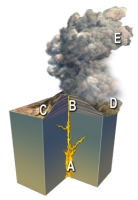
A)A
B)B
C)C
D)D
E)E

A)A
B)B
C)C
D)D
E)E
E
2
What texture is displayed by the igneous rock in this photograph? 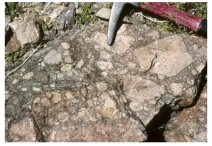
A)vesicles
B)breccia
C)porphyritic
D)glassy
E)none of these

A)vesicles
B)breccia
C)porphyritic
D)glassy
E)none of these
B
3
The site on the accompanying figure that would mostly likely form a rock that is fine grained (has small crystals but is not glassy)is: 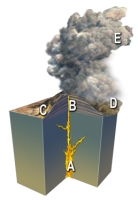
A)A
B)B
C)C
D)D
E)E

A)A
B)B
C)C
D)D
E)E
B
4
Coarsely crystalline igneous textures indicate that:
A)there was a lot of gas in the magma
B)the rock cooled quickly
C)the rock broke apart as it flowed
D)the rock cooled slowly
E)the ash and pumice were hot and became compacted
A)there was a lot of gas in the magma
B)the rock cooled quickly
C)the rock broke apart as it flowed
D)the rock cooled slowly
E)the ash and pumice were hot and became compacted

Unlock Deck
Unlock for access to all 103 flashcards in this deck.
Unlock Deck
k this deck
5
The site on the accompanying figure that would most likely form a rock with large crystals is: 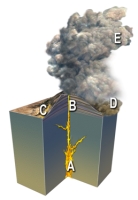
A)A
B)B
C)C
D)D
E)E

A)A
B)B
C)C
D)D
E)E

Unlock Deck
Unlock for access to all 103 flashcards in this deck.
Unlock Deck
k this deck
6
A finely crystalline or glassy igneous texture indicates that:
A)there was a lot of gas in the magma
B)the rock cooled quickly
C)the rock broke apart as it flowed
D)the rock cooled slowly
E)the ash and pumice were hot and became compacted
A)there was a lot of gas in the magma
B)the rock cooled quickly
C)the rock broke apart as it flowed
D)the rock cooled slowly
E)the ash and pumice were hot and became compacted

Unlock Deck
Unlock for access to all 103 flashcards in this deck.
Unlock Deck
k this deck
7
A porphyritic igneous texture indicates that:
A)there was water in the magma
B)the rock cooled slowly and then quickly
C)the rock broke apart as it flowed
D)the rock cooled slowly
E)the ash and pumice were hot and became compacted
A)there was water in the magma
B)the rock cooled slowly and then quickly
C)the rock broke apart as it flowed
D)the rock cooled slowly
E)the ash and pumice were hot and became compacted

Unlock Deck
Unlock for access to all 103 flashcards in this deck.
Unlock Deck
k this deck
8
What texture is displayed by the igneous rock in this photograph? 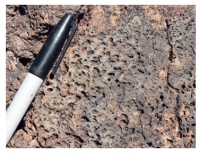
A)vesicles
B)breccia
C)porphyritic
D)glassy
E)none of these

A)vesicles
B)breccia
C)porphyritic
D)glassy
E)none of these

Unlock Deck
Unlock for access to all 103 flashcards in this deck.
Unlock Deck
k this deck
9
The site on the accompanying figure that would most likely form a rock that is glassy with no volcanic ash is: 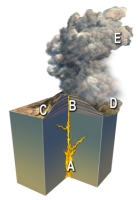
A)A
B)B
C)C
D)D
E)E

A)A
B)B
C)C
D)D
E)E

Unlock Deck
Unlock for access to all 103 flashcards in this deck.
Unlock Deck
k this deck
10
The site on the accompanying figure that would most likely form a rock that has a welded texture is: 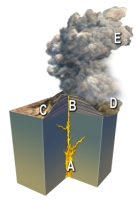
A)A
B)B
C)C
D)D
E)E

A)A
B)B
C)C
D)D
E)E

Unlock Deck
Unlock for access to all 103 flashcards in this deck.
Unlock Deck
k this deck
11
What texture is displayed by the igneous rock in this photograph? 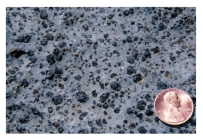
A)vesicles
B)breccia
C)porphyritic
D)glassy
E)none of these

A)vesicles
B)breccia
C)porphyritic
D)glassy
E)none of these

Unlock Deck
Unlock for access to all 103 flashcards in this deck.
Unlock Deck
k this deck
12
A volcanic breccia texture indicates that:
A)there was a lot of gas in the magma
B)the rock cooled quickly
C)the rock broke apart as it flowed
D)the rock cooled slowly
E)the ash and pumice were hot and became compacted
A)there was a lot of gas in the magma
B)the rock cooled quickly
C)the rock broke apart as it flowed
D)the rock cooled slowly
E)the ash and pumice were hot and became compacted

Unlock Deck
Unlock for access to all 103 flashcards in this deck.
Unlock Deck
k this deck
13
What does this texture indicate about the formation of this rock? 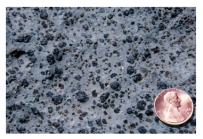
A)It formed from an explosive pyroclastic eruption.
B)The rock solidified at great depth.
C)The magma formed some crystals before rising closer to the surface and solidifying.
D)The magma had abundant dissolved gas.

A)It formed from an explosive pyroclastic eruption.
B)The rock solidified at great depth.
C)The magma formed some crystals before rising closer to the surface and solidifying.
D)The magma had abundant dissolved gas.

Unlock Deck
Unlock for access to all 103 flashcards in this deck.
Unlock Deck
k this deck
14
What does this welded texture indicate about the formation of this rock? 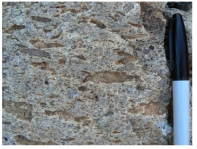
A)It formed from an explosive pyroclastic eruption.
B)The rock solidified at great depth.
C)The magma formed some crystals before rising closer to the surface and solidifying.
D)The magma had abundant dissolved gas.

A)It formed from an explosive pyroclastic eruption.
B)The rock solidified at great depth.
C)The magma formed some crystals before rising closer to the surface and solidifying.
D)The magma had abundant dissolved gas.

Unlock Deck
Unlock for access to all 103 flashcards in this deck.
Unlock Deck
k this deck
15
An igneous pegmatite indicates that:
A)there was water in the magma
B)the rock cooled slowly and then quickly
C)the rock broke apart as it flowed
D)the rock cooled quickly
E)the ash and pumice were hot and became compacted
A)there was water in the magma
B)the rock cooled slowly and then quickly
C)the rock broke apart as it flowed
D)the rock cooled quickly
E)the ash and pumice were hot and became compacted

Unlock Deck
Unlock for access to all 103 flashcards in this deck.
Unlock Deck
k this deck
16
A vesicular igneous texture indicates that:
A)there was a lot of gas in the magma
B)the rock cooled quickly
C)the rock broke apart as it flowed
D)the rock cooled slowly
E)the ash and pumice were hot and became compacted
A)there was a lot of gas in the magma
B)the rock cooled quickly
C)the rock broke apart as it flowed
D)the rock cooled slowly
E)the ash and pumice were hot and became compacted

Unlock Deck
Unlock for access to all 103 flashcards in this deck.
Unlock Deck
k this deck
17
What texture is displayed by the igneous rock in this photograph? 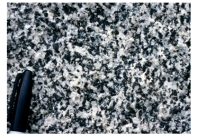
A)vesicles
B)breccia
C)porphyritic
D)glassy
E)none of these

A)vesicles
B)breccia
C)porphyritic
D)glassy
E)none of these

Unlock Deck
Unlock for access to all 103 flashcards in this deck.
Unlock Deck
k this deck
18
Which numbered feature on this figure formed by an explosive pyroclastic eruption? 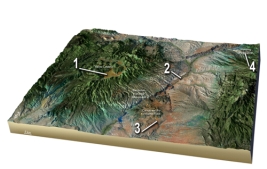
A)Location 1,the Valles Caldera
B)Location 2,dark basalt flows along the Rio Grande
C)Location 3,the dark,basaltic volcanoes
D)Location 4,pegmatite in the northeastern part of the area

A)Location 1,the Valles Caldera
B)Location 2,dark basalt flows along the Rio Grande
C)Location 3,the dark,basaltic volcanoes
D)Location 4,pegmatite in the northeastern part of the area

Unlock Deck
Unlock for access to all 103 flashcards in this deck.
Unlock Deck
k this deck
19
What does this texture indicate about the formation of this rock? 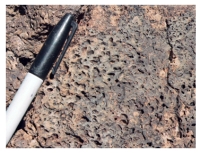
A)It formed from an explosive pyroclastic eruption.
B)The rock solidified at great depth.
C)The magma formed some crystals before rising closer to the surface and solidifying.
D)The magma had abundant dissolved gas.

A)It formed from an explosive pyroclastic eruption.
B)The rock solidified at great depth.
C)The magma formed some crystals before rising closer to the surface and solidifying.
D)The magma had abundant dissolved gas.

Unlock Deck
Unlock for access to all 103 flashcards in this deck.
Unlock Deck
k this deck
20
A welded igneous texture indicates that:
A)there was a lot of gas in the magma
B)the rock cooled quickly
C)the rock broke apart as it flowed
D)the rock cooled slowly
E)the ash and pumice were hot and became compacted
A)there was a lot of gas in the magma
B)the rock cooled quickly
C)the rock broke apart as it flowed
D)the rock cooled slowly
E)the ash and pumice were hot and became compacted

Unlock Deck
Unlock for access to all 103 flashcards in this deck.
Unlock Deck
k this deck
21
Which of the following is the best example of heat transfer by conduction?
A)newly created lithosphere loses heat to adjacent rocks
B)water flows in a circular path in a pan
C)a burner gives heat through the air without touching the object
D)seawater is drawn into a mid-ocean ridge
A)newly created lithosphere loses heat to adjacent rocks
B)water flows in a circular path in a pan
C)a burner gives heat through the air without touching the object
D)seawater is drawn into a mid-ocean ridge

Unlock Deck
Unlock for access to all 103 flashcards in this deck.
Unlock Deck
k this deck
22
Which letter in this classification table indicates the position of basalt? 
A)A
B)B
C)C
D)D
E)E

A)A
B)B
C)C
D)D
E)E

Unlock Deck
Unlock for access to all 103 flashcards in this deck.
Unlock Deck
k this deck
23
Which letter in this classification table indicates the position of gabbro? 
A)A
B)B
C)C
D)D
E)E

A)A
B)B
C)C
D)D
E)E

Unlock Deck
Unlock for access to all 103 flashcards in this deck.
Unlock Deck
k this deck
24
Which of the following photographs depicts an igneous rock where the magma cooled slowly at first and then had fast cooling?
A)
B)
C)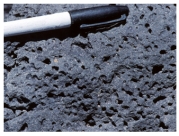
D)
A)

B)

C)

D)


Unlock Deck
Unlock for access to all 103 flashcards in this deck.
Unlock Deck
k this deck
25
Which number on this figure indicates transfer of thermal energy by a convection cell? 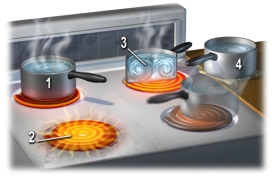
A)1,direct contact between the burner and the pan
B)2,heating by thermal radiation through the air
C)3,heated water expands and rises to the top of the pan and then cools and flows back down
D)4,moving a pan of water away from the stove

A)1,direct contact between the burner and the pan
B)2,heating by thermal radiation through the air
C)3,heated water expands and rises to the top of the pan and then cools and flows back down
D)4,moving a pan of water away from the stove

Unlock Deck
Unlock for access to all 103 flashcards in this deck.
Unlock Deck
k this deck
26
The main process that happens during the alpha type of radioactive decay is:
A)an electron is given off
B)an electron is absorbed and turned into a neutron
C)an atom splits into two pieces
D)an alpha particle combines with a small atom to make a larger one
A)an electron is given off
B)an electron is absorbed and turned into a neutron
C)an atom splits into two pieces
D)an alpha particle combines with a small atom to make a larger one

Unlock Deck
Unlock for access to all 103 flashcards in this deck.
Unlock Deck
k this deck
27
Which number of this figure indicates transfer of thermal energy by conduction? 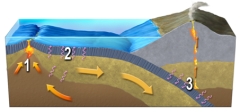
A)1,heating of adjacent rocks by a magma
B)2,cooling of hot lithosphere by contact with cooler rocks and seawater
C)3,heating of the subducted plate by contact with hotter overlying materials
D)all of these

A)1,heating of adjacent rocks by a magma
B)2,cooling of hot lithosphere by contact with cooler rocks and seawater
C)3,heating of the subducted plate by contact with hotter overlying materials
D)all of these

Unlock Deck
Unlock for access to all 103 flashcards in this deck.
Unlock Deck
k this deck
28
Which of the following processes has added heat to Earth's interior during or after its formation?
A)collision of asteroids and meteoroids with Earth
B)formation and sinking of masses of iron and nickel
C)radioactive decay
D)all of these
A)collision of asteroids and meteoroids with Earth
B)formation and sinking of masses of iron and nickel
C)radioactive decay
D)all of these

Unlock Deck
Unlock for access to all 103 flashcards in this deck.
Unlock Deck
k this deck
29
Which of the following rock photographs depicts an igneous rock that trapped gas?
A)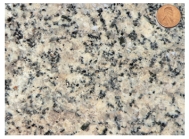
B)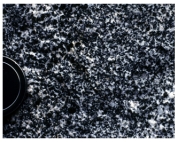
C)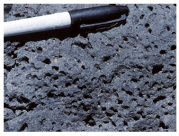
D)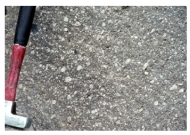
A)

B)

C)

D)


Unlock Deck
Unlock for access to all 103 flashcards in this deck.
Unlock Deck
k this deck
30
Which of the following rock types requires dissolved gas in the magma?
A)granite
B)pumice
C)gabbro
D)diorite
E)andesite
A)granite
B)pumice
C)gabbro
D)diorite
E)andesite

Unlock Deck
Unlock for access to all 103 flashcards in this deck.
Unlock Deck
k this deck
31
Which number on this figure indicates heating by conduction? 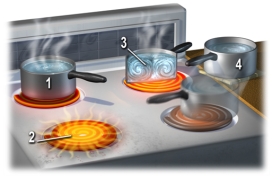
A)1,direct contact between the burner and the pan
B)2,heating by thermal radiation through the air
C)3,heated water expands and rises to the top of the pan and then cools and flows back down
D)4,moving a pan of water away from the stove

A)1,direct contact between the burner and the pan
B)2,heating by thermal radiation through the air
C)3,heated water expands and rises to the top of the pan and then cools and flows back down
D)4,moving a pan of water away from the stove

Unlock Deck
Unlock for access to all 103 flashcards in this deck.
Unlock Deck
k this deck
32
Which of the following rock types does NOT involve dissolved gas in the magma?
A)tuff
B)pumice
C)scoria
D)diorite
E)vesicular basalt
A)tuff
B)pumice
C)scoria
D)diorite
E)vesicular basalt

Unlock Deck
Unlock for access to all 103 flashcards in this deck.
Unlock Deck
k this deck
33
Which of the following is an example of heat transfer by convection?
A)water within a pan is heated and flows in a circular path
B)seawater is drawn into a mid-ocean ridge,heated,and rises
C)the rise of material beneath mid-ocean ridges coupled with subduction
D)all of these
A)water within a pan is heated and flows in a circular path
B)seawater is drawn into a mid-ocean ridge,heated,and rises
C)the rise of material beneath mid-ocean ridges coupled with subduction
D)all of these

Unlock Deck
Unlock for access to all 103 flashcards in this deck.
Unlock Deck
k this deck
34
Which letter in this classification table indicates the position of rhyolite? 
A)A
B)B
C)C
D)D
E)E

A)A
B)B
C)C
D)D
E)E

Unlock Deck
Unlock for access to all 103 flashcards in this deck.
Unlock Deck
k this deck
35
Which of the following igneous rocks can be composed of fragments?
A)tuff
B)scoria
C)volcanic breccia
D)all of these
A)tuff
B)scoria
C)volcanic breccia
D)all of these

Unlock Deck
Unlock for access to all 103 flashcards in this deck.
Unlock Deck
k this deck
36
Which of the following is the best example of heat transfer by conduction?
A)a pan is placed directly on a burner
B)water within the pan flows in a circular path
C)a burner gives heat through the air without touching the object
D)seawater is drawn into a mid-ocean ridge
A)a pan is placed directly on a burner
B)water within the pan flows in a circular path
C)a burner gives heat through the air without touching the object
D)seawater is drawn into a mid-ocean ridge

Unlock Deck
Unlock for access to all 103 flashcards in this deck.
Unlock Deck
k this deck
37
Which of the following rock photographs depicts a felsic igneous rock?
A)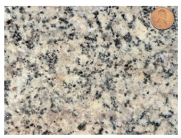
B)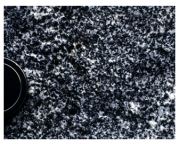
C)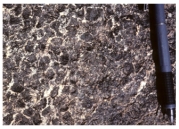
D)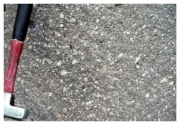
A)

B)

C)

D)


Unlock Deck
Unlock for access to all 103 flashcards in this deck.
Unlock Deck
k this deck
38
Which letter in this classification table indicates the position of andesite? 
A)A
B)B
C)C
D)D
E)E

A)A
B)B
C)C
D)D
E)E

Unlock Deck
Unlock for access to all 103 flashcards in this deck.
Unlock Deck
k this deck
39
Which of the following can occur within a magma chamber?
A)Sinking or floating crystals may change the composition of the remaining magma.
B)Wall rocks can melt and become incorporated into the magma.
C)If two magmas mix,the resulting magma would be between the composition of the two magmas.
D)All of these.
A)Sinking or floating crystals may change the composition of the remaining magma.
B)Wall rocks can melt and become incorporated into the magma.
C)If two magmas mix,the resulting magma would be between the composition of the two magmas.
D)All of these.

Unlock Deck
Unlock for access to all 103 flashcards in this deck.
Unlock Deck
k this deck
40
Which letter in this classification table indicates the position of granite? 
A)A
B)B
C)C
D)D
E)E

A)A
B)B
C)C
D)D
E)E

Unlock Deck
Unlock for access to all 103 flashcards in this deck.
Unlock Deck
k this deck
41
How does the addition of water cause melting?
A)it heats the rocks
B)it decreases the pressure on the rocks
C)it increases the temperature while decreasing the pressure
D)it changes the location of the liquid-solid boundary
A)it heats the rocks
B)it decreases the pressure on the rocks
C)it increases the temperature while decreasing the pressure
D)it changes the location of the liquid-solid boundary

Unlock Deck
Unlock for access to all 103 flashcards in this deck.
Unlock Deck
k this deck
42
Which are important ways that magma can raise through the crust?
A)through fractures that can form dikes
B)pieces of the wall rocks that break off and provide space
C)tectonic forces can help open pathways
D)magma is hotter and less dense than its surrounding
E)all of these
A)through fractures that can form dikes
B)pieces of the wall rocks that break off and provide space
C)tectonic forces can help open pathways
D)magma is hotter and less dense than its surrounding
E)all of these

Unlock Deck
Unlock for access to all 103 flashcards in this deck.
Unlock Deck
k this deck
43
Which of the following processes could result in a felsic magma?
A)partial melting of an intermediate-composition source
B)partial melting of continental crust
C)formation and settling of mafic crystals in an intermediate magma
D)all of these
A)partial melting of an intermediate-composition source
B)partial melting of continental crust
C)formation and settling of mafic crystals in an intermediate magma
D)all of these

Unlock Deck
Unlock for access to all 103 flashcards in this deck.
Unlock Deck
k this deck
44
What does the texture of this rock indicate about its cooling history? The magma cooled: 
A)entirely at the surface
B)for a while at some depth and then rose to the surface where it finished solidifying
C)slowly under relatively deep conditions
D)slowly in the presence of water

A)entirely at the surface
B)for a while at some depth and then rose to the surface where it finished solidifying
C)slowly under relatively deep conditions
D)slowly in the presence of water

Unlock Deck
Unlock for access to all 103 flashcards in this deck.
Unlock Deck
k this deck
45
Which of the following changes in conditions would represent heating during burial? 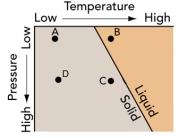
A)from A to B
B)from B to C
C)from C to D
D)from D to A
E)from A to C

A)from A to B
B)from B to C
C)from C to D
D)from D to A
E)from A to C

Unlock Deck
Unlock for access to all 103 flashcards in this deck.
Unlock Deck
k this deck
46
What does the texture of this rock indicate about its cooling history? The magma cooled: 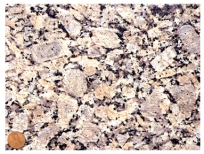
A)entirely at the surface
B)for a while at some depth and then rose to the surface where it finished solidifying
C)slowly under relatively deep conditions
D)slowly and underwater

A)entirely at the surface
B)for a while at some depth and then rose to the surface where it finished solidifying
C)slowly under relatively deep conditions
D)slowly and underwater

Unlock Deck
Unlock for access to all 103 flashcards in this deck.
Unlock Deck
k this deck
47
When melting forms magma:
A)rocks in the source region generally are completely melted
B)partial melting produces a magma that is more felsic than the source
C)melting of the mantle generally produces felsic magma
D)melting of continental crust generally produces mafic magma
E)none of these
A)rocks in the source region generally are completely melted
B)partial melting produces a magma that is more felsic than the source
C)melting of the mantle generally produces felsic magma
D)melting of continental crust generally produces mafic magma
E)none of these

Unlock Deck
Unlock for access to all 103 flashcards in this deck.
Unlock Deck
k this deck
48
Which of the following is likely to be true about the magma that formed the left volcanic feature compared to the right one in this figure? 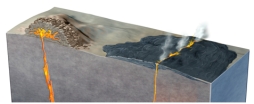
A)the magma has a higher viscosity
B)the magma has a higher silicate content
C)the magma is probably more felsic
D)all of these

A)the magma has a higher viscosity
B)the magma has a higher silicate content
C)the magma is probably more felsic
D)all of these

Unlock Deck
Unlock for access to all 103 flashcards in this deck.
Unlock Deck
k this deck
49
Which of the following changes in conditions would cause melting of a solid rock? 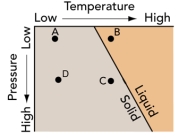
A)from A to B
B)from B to C
C)from C to D
D)from A to D
E)from A to C

A)from A to B
B)from B to C
C)from C to D
D)from A to D
E)from A to C

Unlock Deck
Unlock for access to all 103 flashcards in this deck.
Unlock Deck
k this deck
50
Which of the following is common during crystallization of a magma?
A)felsic minerals crystallize first
B)mafic minerals are light and float in most magma chambers
C)felsic crystals are heavy and sink in most magma chambers
D)all crystals form at about the same time
E)none of these
A)felsic minerals crystallize first
B)mafic minerals are light and float in most magma chambers
C)felsic crystals are heavy and sink in most magma chambers
D)all crystals form at about the same time
E)none of these

Unlock Deck
Unlock for access to all 103 flashcards in this deck.
Unlock Deck
k this deck
51
Which of the following causes magma to be less viscous?
A)a lower temperature
B)fewer silicate chains in the magma
C)a more felsic composition
D)a higher percentage of crystals
E)none of these
A)a lower temperature
B)fewer silicate chains in the magma
C)a more felsic composition
D)a higher percentage of crystals
E)none of these

Unlock Deck
Unlock for access to all 103 flashcards in this deck.
Unlock Deck
k this deck
52
The liquid-solid boundary on this graph slopes down and to the right because: 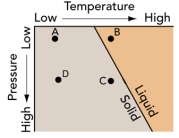
A)temperature increases down in the earth
B)temperature decreases down in the earth
C)pressure increases down in the earth
D)none of these

A)temperature increases down in the earth
B)temperature decreases down in the earth
C)pressure increases down in the earth
D)none of these

Unlock Deck
Unlock for access to all 103 flashcards in this deck.
Unlock Deck
k this deck
53
Which of the following changes in conditions represents decompression melting? 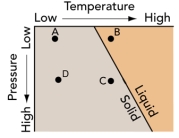
A)from A to B
B)from B to A
C)from B to C
D)from C to B
E)from D to A

A)from A to B
B)from B to A
C)from B to C
D)from C to B
E)from D to A

Unlock Deck
Unlock for access to all 103 flashcards in this deck.
Unlock Deck
k this deck
54
Which of the following factors helps magma rise toward Earth's surface?
A)pressure decreases with increasing depth
B)magma is more dense and therefore tougher than the surrounding solid rocks
C)gas bubbles generally form at great depth and drive magma upward
D)none of these
A)pressure decreases with increasing depth
B)magma is more dense and therefore tougher than the surrounding solid rocks
C)gas bubbles generally form at great depth and drive magma upward
D)none of these

Unlock Deck
Unlock for access to all 103 flashcards in this deck.
Unlock Deck
k this deck
55
Which of the following changes in conditions represents the main cause of melting beneath mid-ocean ridges? 
A)from A to B
B)from A to C
C)from A to D
D)from C to B
E)from D to B

A)from A to B
B)from A to C
C)from A to D
D)from C to B
E)from D to B

Unlock Deck
Unlock for access to all 103 flashcards in this deck.
Unlock Deck
k this deck
56
Which of the following changes in conditions indicates heating of the rock? 
A)from A to B
B)from B to C
C)from C to D
D)from D to A
E)none of these

A)from A to B
B)from B to C
C)from C to D
D)from D to A
E)none of these

Unlock Deck
Unlock for access to all 103 flashcards in this deck.
Unlock Deck
k this deck
57
How could a rock at point C be melted? 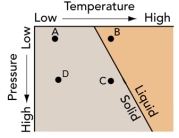
A)increase in temperature
B)decrease in pressure
C)increase in temperature accompanied by a decrease in pressure
D)all of these

A)increase in temperature
B)decrease in pressure
C)increase in temperature accompanied by a decrease in pressure
D)all of these

Unlock Deck
Unlock for access to all 103 flashcards in this deck.
Unlock Deck
k this deck
58
Which of the following changes in conditions could represent melting of continental crust from the introduction of a mafic magma? 
A)from A to B
B)from A to C
C)from A to D
D)from C to B
E)from B to D

A)from A to B
B)from A to C
C)from A to D
D)from C to B
E)from B to D

Unlock Deck
Unlock for access to all 103 flashcards in this deck.
Unlock Deck
k this deck
59
Which of the following acts to keep a rock solid (instead of melting)?
A)an increase in temperature
B)an increase in the vibration within a lattice
C)an increase in confining pressure
D)none of these
A)an increase in temperature
B)an increase in the vibration within a lattice
C)an increase in confining pressure
D)none of these

Unlock Deck
Unlock for access to all 103 flashcards in this deck.
Unlock Deck
k this deck
60
Which of the following is likely to be true about the left volcanic feature compared to the right one in this figure? 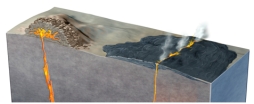
A)the magma has a higher viscosity
B)the magma has fewer silicate chains
C)the magma probably formed at a higher temperature
D)all of these

A)the magma has a higher viscosity
B)the magma has fewer silicate chains
C)the magma probably formed at a higher temperature
D)all of these

Unlock Deck
Unlock for access to all 103 flashcards in this deck.
Unlock Deck
k this deck
61
A hot spot is interpreted to have formed from:
A)extreme heating of the seas near the equator
B)abundant magma produced within a subduction zone
C)abundant magma formed within a typical mid-ocean ridge
D)a rising plume of hot mantle material
A)extreme heating of the seas near the equator
B)abundant magma produced within a subduction zone
C)abundant magma formed within a typical mid-ocean ridge
D)a rising plume of hot mantle material

Unlock Deck
Unlock for access to all 103 flashcards in this deck.
Unlock Deck
k this deck
62
What is typically occurring when magmatism occurs far away from plate boundaries?
A)new oceanic crust is created at mid-ocean ridges
B)large volcanoes are built above subduction zones
C)some type of thermal disturbance is occurring in the mantle
D)all of these
A)new oceanic crust is created at mid-ocean ridges
B)large volcanoes are built above subduction zones
C)some type of thermal disturbance is occurring in the mantle
D)all of these

Unlock Deck
Unlock for access to all 103 flashcards in this deck.
Unlock Deck
k this deck
63
Which of the following is true about igneous processes along oceanic divergent boundaries as shown in this figure? 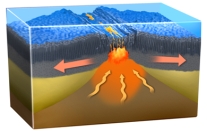
A)Oceanic crust moves toward the ridge in a conveyor-belt manner.
B)Most of the mantle is molten,not solid.
C)Solid asthenosphere rises as plates move apart.
D)Magma generated in the crust drips down into the mantle.

A)Oceanic crust moves toward the ridge in a conveyor-belt manner.
B)Most of the mantle is molten,not solid.
C)Solid asthenosphere rises as plates move apart.
D)Magma generated in the crust drips down into the mantle.

Unlock Deck
Unlock for access to all 103 flashcards in this deck.
Unlock Deck
k this deck
64
Hot spots in continental settings typically produce:
A)high continental plateaus,such as in Tibet
B)lines or clusters of islands
C)basaltic lava flows or explosive calderas
D)new oceanic crust
A)high continental plateaus,such as in Tibet
B)lines or clusters of islands
C)basaltic lava flows or explosive calderas
D)new oceanic crust

Unlock Deck
Unlock for access to all 103 flashcards in this deck.
Unlock Deck
k this deck
65
A mantle plume rises because:
A)it is mostly molten
B)it is solid but less dense than material around it
C)it is molten and more dense than material around it
D)it is propelled upward by gas coming out of the magma
A)it is mostly molten
B)it is solid but less dense than material around it
C)it is molten and more dense than material around it
D)it is propelled upward by gas coming out of the magma

Unlock Deck
Unlock for access to all 103 flashcards in this deck.
Unlock Deck
k this deck
66
Which of the following occurs during a continental collision,after any subduction has ended?
A)the descending continental plate gets hotter and decreases in pressure
B)decreasing pressure causes downgoing crust to melt
C)volcanoes are widespread above continental collisions
D)all of these
E)none of these
A)the descending continental plate gets hotter and decreases in pressure
B)decreasing pressure causes downgoing crust to melt
C)volcanoes are widespread above continental collisions
D)all of these
E)none of these

Unlock Deck
Unlock for access to all 103 flashcards in this deck.
Unlock Deck
k this deck
67
Which of the following igneous rocks has a texture consistent with a magma that cooled and solidified slowly at first,followed by more rapid cooling?
A)small felsic crystals enclosed in large mafic ones
B)small mafic crystals enclosed in large felsic ones
C)large crystals like those in pegmatite
D)large,early formed crystals surrounded by smaller,late formed crystals
A)small felsic crystals enclosed in large mafic ones
B)small mafic crystals enclosed in large felsic ones
C)large crystals like those in pegmatite
D)large,early formed crystals surrounded by smaller,late formed crystals

Unlock Deck
Unlock for access to all 103 flashcards in this deck.
Unlock Deck
k this deck
68
The main cause of melting along subduction zones is the:
A)rise and decompression melting of mantle lithosphere
B)rise and decompression melting of mantle asthenosphere
C)melting of the subducting plate
D)release of water from the subducting plate
A)rise and decompression melting of mantle lithosphere
B)rise and decompression melting of mantle asthenosphere
C)melting of the subducting plate
D)release of water from the subducting plate

Unlock Deck
Unlock for access to all 103 flashcards in this deck.
Unlock Deck
k this deck
69
Which of the following is NOT a way that magma can lose heat to begin solidifying?
A)conduction to surrounding solid rocks
B)loss of thermal energy to the air and water
C)water that is heated and circulated near the magma
D)an increase in the rate of radioactive decay
A)conduction to surrounding solid rocks
B)loss of thermal energy to the air and water
C)water that is heated and circulated near the magma
D)an increase in the rate of radioactive decay

Unlock Deck
Unlock for access to all 103 flashcards in this deck.
Unlock Deck
k this deck
70
Which of the following igneous rocks is NOT characteristic of mid-ocean ridges?
A)finely crystalline rocks that formed in dikes
B)gabbro that solidified in a magma chamber
C)pillow basalt
D)andesite and granodiorite
A)finely crystalline rocks that formed in dikes
B)gabbro that solidified in a magma chamber
C)pillow basalt
D)andesite and granodiorite

Unlock Deck
Unlock for access to all 103 flashcards in this deck.
Unlock Deck
k this deck
71
On this figure of Bowen's Reaction Series,which mineral would crystallize last from magma? 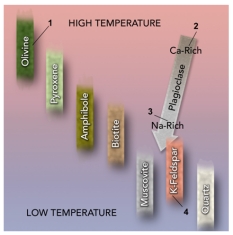
A)1,olivine
B)2,calcium-rich plagioclase
C)3,sodium-rich plagioclase
D)4,K-feldspar

A)1,olivine
B)2,calcium-rich plagioclase
C)3,sodium-rich plagioclase
D)4,K-feldspar

Unlock Deck
Unlock for access to all 103 flashcards in this deck.
Unlock Deck
k this deck
72
What is a path for magma as it solidifies at great depth and then is uplifted slowly toward the surface? 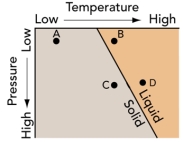
A)from B to A
B)from C to A
C)from C to B to A
D)from D to C to B
E)from D to C to A

A)from B to A
B)from C to A
C)from C to B to A
D)from D to C to B
E)from D to C to A

Unlock Deck
Unlock for access to all 103 flashcards in this deck.
Unlock Deck
k this deck
73
Which of the following minerals would likely crystallize early from magma?
A)mafic minerals
B)quartz
C)muscovite
D)potassium feldspar
A)mafic minerals
B)quartz
C)muscovite
D)potassium feldspar

Unlock Deck
Unlock for access to all 103 flashcards in this deck.
Unlock Deck
k this deck
74
Which of the following is characteristic of continental rifts? 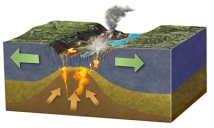
A)some magmas are felsic and intermediate
B)heat from hot,mafic magma can melt continental crust
C)solid asthenosphere undergoes decompression melting
D)all of these

A)some magmas are felsic and intermediate
B)heat from hot,mafic magma can melt continental crust
C)solid asthenosphere undergoes decompression melting
D)all of these

Unlock Deck
Unlock for access to all 103 flashcards in this deck.
Unlock Deck
k this deck
75
The main way water gets into a subduction zone is by:
A)heating of the overlying continental crust
B)a decrease in pressure that causes melting
C)rain associated with eruptions in the island arc
D)seawater introduced into oceanic crust at the mid-ocean ridge,prior to subduction
E)all of these
A)heating of the overlying continental crust
B)a decrease in pressure that causes melting
C)rain associated with eruptions in the island arc
D)seawater introduced into oceanic crust at the mid-ocean ridge,prior to subduction
E)all of these

Unlock Deck
Unlock for access to all 103 flashcards in this deck.
Unlock Deck
k this deck
76
Hot spots in oceanic settings typically produce:
A)flood basalts in the middle of a continent
B)huge caldera explosions
C)island arcs
D)lines or clusters of volcanic islands
A)flood basalts in the middle of a continent
B)huge caldera explosions
C)island arcs
D)lines or clusters of volcanic islands

Unlock Deck
Unlock for access to all 103 flashcards in this deck.
Unlock Deck
k this deck
77
What generally happens when subduction-derived magma encounters thick continental crust?
A)most magma reaches the surface with minor modification
B)the magma solidifies in sheeted dikes with a composition of basalt
C)the magma interacts with the crust,forming felsic or intermediate compositions
D)the oceanic crust melts
A)most magma reaches the surface with minor modification
B)the magma solidifies in sheeted dikes with a composition of basalt
C)the magma interacts with the crust,forming felsic or intermediate compositions
D)the oceanic crust melts

Unlock Deck
Unlock for access to all 103 flashcards in this deck.
Unlock Deck
k this deck
78
Which of the following igneous rocks would be formed by the slowest cooling?
A)coarse granite
B)medium-grained granite
C)fine-grained granite
D)volcanic glass
E)there is not enough information to tell
A)coarse granite
B)medium-grained granite
C)fine-grained granite
D)volcanic glass
E)there is not enough information to tell

Unlock Deck
Unlock for access to all 103 flashcards in this deck.
Unlock Deck
k this deck
79
Which of the following igneous rocks would be formed by the fastest cooling?
A)very coarse granite pegmatite
B)coarse granite
C)medium-grained granite
D)fine-grained granite
E)volcanic glass
A)very coarse granite pegmatite
B)coarse granite
C)medium-grained granite
D)fine-grained granite
E)volcanic glass

Unlock Deck
Unlock for access to all 103 flashcards in this deck.
Unlock Deck
k this deck
80
Which of the following settings is most likely to have eruptions of basalt?
A)island arcs
B)subduction beneath a thin continental plate
C)subduction beneath a thick continental plate
D)mid-ocean ridge
E)none of these
A)island arcs
B)subduction beneath a thin continental plate
C)subduction beneath a thick continental plate
D)mid-ocean ridge
E)none of these

Unlock Deck
Unlock for access to all 103 flashcards in this deck.
Unlock Deck
k this deck



